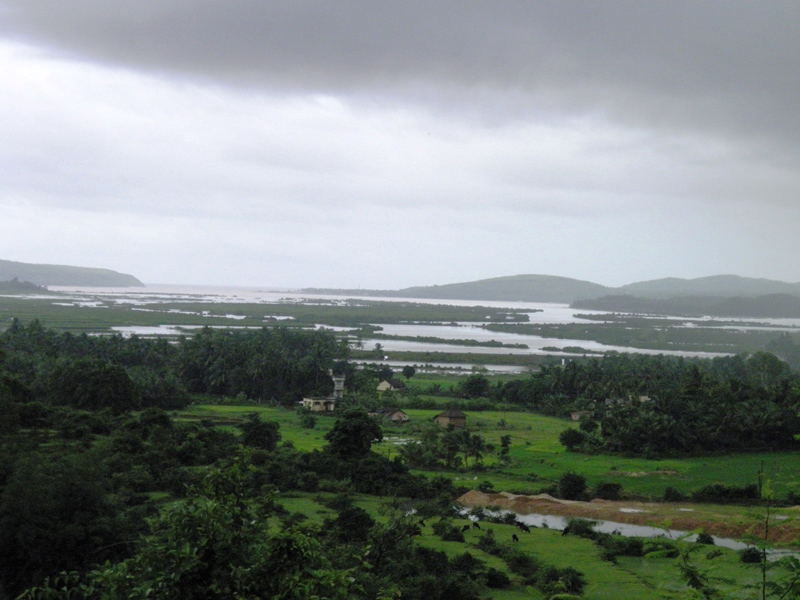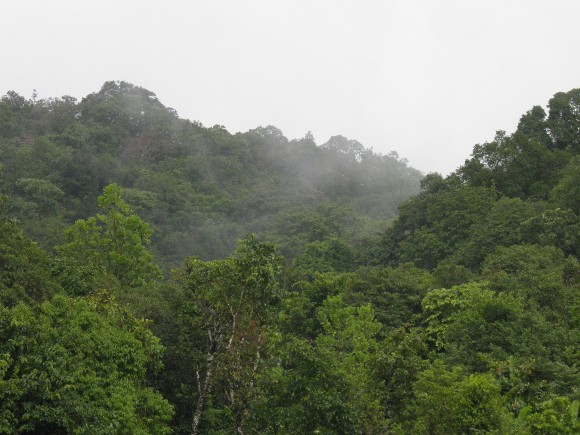Decks cleared for the Hubli-Ankola railway, reads a popular news headline. The institution responsible for allowing this, according to the newspapers, was the National Green Tribunal (NGT) which in its decision reversed certain earlier recommendations suggesting that no application related to the forest diversion related to this project should be considered by India’s Ministry of Environment, Forests and Climate Change (MoEFCC). But does this mean that the railway line is approved?
Understanding the actual decision of the NGT requires us to rewind approximately 10 years, and to go back to the time when these plans materialised, perhaps another decade. In the year 1997-1998 the Ministry of Railways sanctioned the construction of the 168.289 KM broad gauge railway line from Hubli (Dharwad District) to Ankola (Uttara Kannada District) of Karnataka, to provide a direct rail link to the coast.
Western Ghats, Uttara Kannada. Pic: Kanchi Kohli
The total land required for the execution of this project is 1384.40 ha out of which 965 ha was originally proposed to be forest land. This figure has over the years reduced to 667 ha of reserve forest land falling in Dharwad and Uttara Kannada districts of the state. Using this land for the construction of the railway line requires approval under India’s Forest Conservation Act, 1980.
However, the foundation stone for the project was laid in May 2000 by then Prime Minister, Atal Bihari Vajpayee. Unfortunately, this was well before the approval to use forest land for the construction was in place.
The original challenge
When it was reported that the construction on the railway line is underway in early 2006, the issue was brought to the notice of the Central Empowered Committee (CEC), a monitoring body on forest matters constituted by the Supreme Court of India in 2002. Back then, the CEC was constituted to assist the SC as part of the ongoing T N Godavarman Thirumulkpad vs Union of India.
The application was filed before the CEC by two Karnataka based NGOs: Parisara Samrakshana Kendra, Sirsi, Uttara Kannada and Wilderness Club, Bangalore. The application was filed with the legal support of Ritwick Dutta of the Legal Initiative for Forests and Environment (LIFE).
What triggered this legal challenge was construction activities being initiated by the railways department in the 40-km stretch of the non-forest portion of the land in question. However, such a practice has often posed a larger question around the fait accompli in such a decision. Once investment is already made on the non-forest portion, this investment made for the project can and has been used to influence a favourable decision. MoEFCC therefore has a set of guidelines, which lays out why such an activity is not favourable.
According to the August 2015 report of the Central Empowered Committee (CEC) submitted to the SC, the state government has on the one hand made “strong and convincing” submissions stating that the construction of the railway line will cause severe damage to the “pristine” Western Ghats forests. At the same time, the government has argued for the need of this railway line for the “social and economic development of backward Uttara Karnataka”.
Back in 2006, when I wrote at India Together, on the legal challenges of this project, the purpose of this railway line was pretty much what it seems to be now. One of the main reasons that the Government of Karnataka had been pushing for the construction of this line, is to transport iron and manganese from the Bellary region of the state to the coast.

The area where the Tadri sea port is proposed to come up. Pic: Kanchi Kohli
A more recent twist to this has been the proposed construction of state’s largest port at Tadri in Uttara Kannada district. Two linked elements to aid the transportation of the iron ore to the port are the railway line as well as the expansion of the National Highway 63.
The CEC report of August 2015, also records both these reasons as being arguments used by the state government to push for the railway line.
The CEC’s 2015 recommendations
In August 2015, the CEC in their final report to the SC, made some interesting observations and recommendations. It first referred to the directions of the SC in the legal case related to iron ore mining in the Bellary-Hospet sector. The report recorded that pursuant to May 2011 orders of the SC, the production from this area has significantly reduced and in fact, no export has taken place from this sector for the last four years.
Based on the understanding that this scenario is unlikely to change in the future, the CEC concluded that “in all probability the proposed railway line is not likely to have any iron ore cargo available for transportation to ports for exports”.
The report also relies on several other observations made at the time when this project was being both proposed for forest diversion by the Karnataka Forest Department as well as being considered at the erstwhile Ministry of Environment and Forests (MoEF).
Arguments against the project ranged from the terrain not being suitable for a railway line to how the construction of the railway line will fragment the forests and expose new areas to anthropogenic pressures. While the Government of Karnataka concluded that this was an inevitable loss in the light of the importance of the railway line, the environment ministry’s Forest Advisory Committee (FAC) concluded otherwise in June 2004. Even as a revised proposal was pending before the FAC, the initiation of the construction activity was challenged before the SC.
The CEC report also refers to the recommendations of the Indian Institute of Science, Bengaluru (llSc) which was engaged by the Government of Karnataka to carry out Environment Impact Assessment (EIA) studies and to prepare the Environment Management Plan (EMP) on the railway line.
In its Technical Report submitted in February, 2012, IISc observes that the area in question is extremely ecologically fragile with several endemic tree species; in addition, it is also a migratory route for elephants. However, the report also includes an EMP, specifying possible mitigatory measures if the railway line is constructed.
Given the above-mentioned factors, the CEC’s August 2015 report states that, “No amount of mitigative measures would be adequate to contain the severe adverse impact of the project on the biodiversity rich dense forest of Western Ghats and ecology within reasonable limits. Therefore, the proposal for diversion of forest land, rejected on merit by the MoEF under the Forest (Conservation) Act, 1980 on ecological and environmental considerations should not now be reviewed or approved”.
It further recommends the SC to instruct the Ministry of Environment Forests and Climate Change (MoEFCC) not to consider a proposal for the diversion of forest land for non-forest use.
What the NGT concluded
On 5 October 2015 the Supreme Court’s Green Bench while hearing the matters under Writ Petition (Civil) 202 of 1995 i.e. the Godavarman case, issued directions to expedite the disposal of several pending cases. One of the cases that was transferred to the National Green Tribunal (NGT) was that of the Hubli-Ankola railway line.
The existing case number under the SC’s Godavarman bench i.e. I.A. No. 1168 of 2015 was renumbered as M.A. No. 1168 of 2015 (I.A. No. 3897 of 2015) In W.P. (C) No. 202 of 1995. In the NGT with this, the decision on the 2006 petition filed over construction activity on the railway line and the CEC’s recommendations of August 2015 now rests with the NGT.
The NGT in its order dated 10 February 2016 concludes that making an application to use forest land for non-forest use, as in the case of the Hubli-Ankola railway line, is a right available to a project proponent and/or a state government. Such an application has to be dealt with in accordance with law.
The NGT’s order now gives “liberty to the Project Proponent” to submit a proposal to the state government seeking permission to use the forest land for non-forest use; the state government, after review, will take prior approval of the MoEFCC as per the procedure required under the Forest Conservation Act, 1980.

The order also states that the present bench has not dealt with the merits of the case. It further directs that in case there is a fresh application for forest diversion which is granted approval both by the MoEFCC and the state government, it can be challenged before the NGT. Since the entire case is not disposed off, any such challenge will be tagged with the present application, which has been transferred to them from the SC.
While the project proponents might be relieved given that they can now initiate an application for forest diversion, the orders of the NGT do not necessarily imply a complete green signal for the Hubli-Ankola railway line which is the impression created by media reports.
The history of various institutional observations, reports of the forest department, CEC and expert bodies which confirm ecological fragility and irreparable damage, will come into play even when the matter is being considered by all agencies again and if approved, in the court as well. The railway line continues to draw its justification for exporting the ore from Bellary-Hospet region, which according to the CEC report still remain in uncertain.
However, the question remains whether the SC or the NGT, based on the CEC’s recommendations, could direct the ministry not to consider the proposal for forest diversion. Is this legally tenable? This is surely going to open up important debates if conversations are initiated, whether at a chai shop, conference room or even back in court.
For now, the developments around this railway line, and all that is associated with it (Eg. mining in Bellary-Hospet as well as the Tadri port), will certainly be something to watch out for.
























